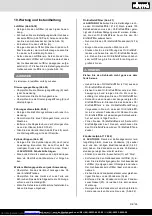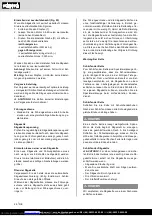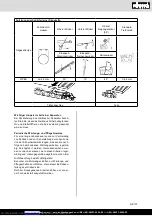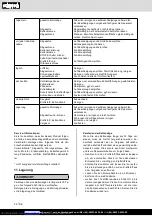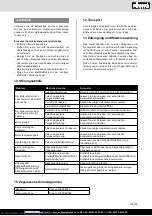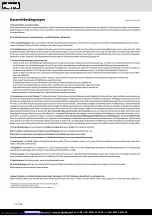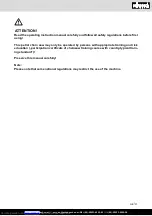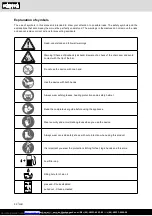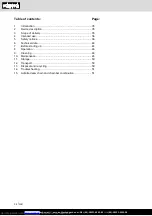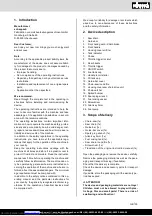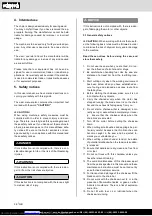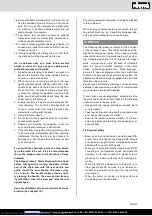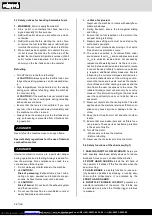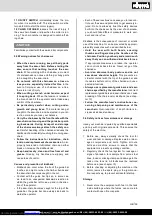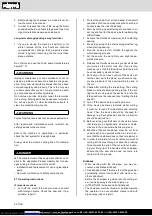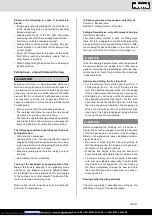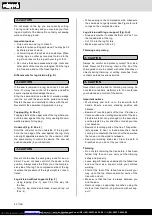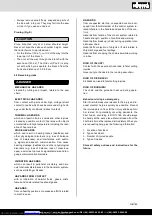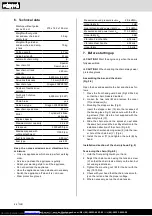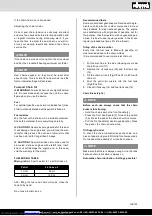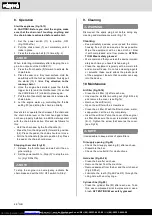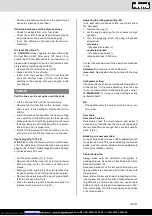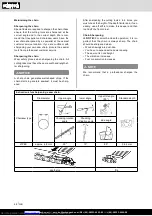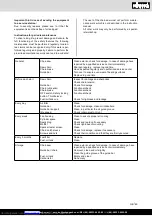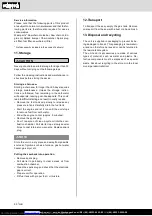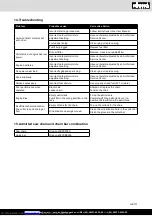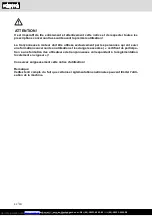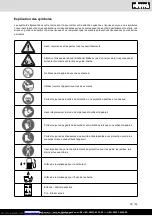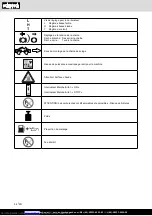
www.scheppach.com /
+(49)-08223-4002-99 /
+(49)-08223-4002-58
GB
| 39
• Each of these reactions can cause you to lose con
-
trol over the saw and potentially to get severely in-
jured. Do not exclusively trust the safety devices
built into the chainsaw. As the user of a chainsaw,
you should take different measures to work acci-
dent and injury free.
Kickback is the consequence of incorrect or erratic
use of the machine. It can be prevented by appropri-
ate safety measures such as described below:
•
Hold the saw with both hands, ensuring
thumbs and fingers clasp the handles of the
chainsaw. Position your body and arms in such
a way that you can withstand kickback forces.
If appropriate measures are taken, the operator
can control kickback forces. Never let go of the
chainsaw.
•
Avoid an abnormal body posture and do not
saw above shoulder height.
This prevents ac-
cidental contact with the tip of the guide bar and
it enables better control of the chainsaw in unex-
pected situations.
•
Always use replacement guide bars and saw-
chains specified by the manufacturer.
Incorrect
replacement guide bars and saw-chains can cause
breaking of the chain and/or kickback. (see chap-
ter 13)
•
Follow the manufacturer‘s instructions con
-
cerning sharpening and maintenance of the
saw-chain.
Over-reduction of depth limiters in-
creases kickback tendency.
5.6 Safety notices for maintenance / storage
Have your machine repaired by qualified specialists
and only with original spare parts. This ensures the
safety of the machine.
1. Before use, always visually check the tool for
wear and tear or damage. Replace worn or dam-
aged components and bolts. Tighten all nuts,
bolts and machine screws to ensure that the
equipment is in a safe operating condition.
2. Regularly check the fuel system for leakage or
signs of abrasion, for example from porous fuel
lines, loose or missing clamps and damage to the
tank or the tank lid. All faults must be resolved
before use. (see chapter 13)
3. Before checking or adjusting the machine or the
motor, remove the spark plug or the ignition ca-
ble, respectively, to prevent accidental start-up.
Storage
1. Never store the equipment with fuel in the tank
inside buildings where the fumes can come into
contact with open fire or sparks.
11 ON/OFF SWITCH
immediately stops the mo
-
tor when it is switched off. The stop switch must be
turned to ON to start the motor (again).
18 CHAIN CATCHER
reduces the risk of injury if
the saw-chain breaks or slips when the motor is run-
ning. The chain catcher is designed to catch a flail-
ing chain.
m
NOTICE
Familiarise yourself with the saw and its components.
5.5 Warning notices for chainsaws
•
When the saw is running, keep all body parts
away from the saw-chain. Before starting the
saw, ensure that nothing touches the saw-
chain.
When working with a chainsaw, a moment
of carelessness can cause clothing or body parts
to be caught by the saw-chain.
•
Do not work with this chainsaw on a tree un
-
less you are especially trained for this.
In the
event of improper use of a chainsaw on a tree,
there is a risk of injury.
•
When cutting a branch under tension, expect
it to spring back.
When the tension is released,
the branch can hit the operator and/or take away
control of the chainsaw.
•
Be particularly careful when cutting under
-
growth and young trees.
Thin material can get
caught in the saw-chain and be ejected in your di-
rection or make you lose your balance.
•
Carry the chainsaw by the front handle with the
saw-chain not moving and the guide bar point
-
ing backwards. During transport and storage
of the chainsaw always attach the safety cov
-
er.
Careful handling of the chainsaw reduces the
likelihood of accidentally touching the running saw-
chain.
•
Follow the instructions for lubrication, chain
tension and replacement of accessories.
An im
-
properly tensioned or lubricated chain can either
break or increase the kickback risk.
•
Keep handles dry, clean and free from oil and
grease.
Greasy, oily handles are slippery and
cause loss of control.
Causes and prevention of kickback:
•
Kickback can occur when the tip of the guide bar
touches an object or when the timber bends and
the saw-chain becomes caught in the cut.
•
Contact with the guide bar tip can, in some cas-
es, lead to an unexpected backwards reaction in
which the guide bar is thrown up and in the direc-
tion of the operator.
•
If the saw-chain becomes caught at the top of the
guide bar, the guide bar can quickly kick back to-
wards the operator.
Heruntergeladen von
Handbücher-Suchmachiene

